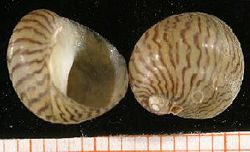Neritopsina
| Neritopsina |
|---|

|
| Scientific Classification |
|
| Superfamilies |
|
Order: Neritoida
|
There is not much known about the Neritopsina. This unique snail is both aquatic and terrestrial. Neritopsinas are in their own order – also called Neritopsina – and not enough is known about them to go any farther down the chart. The shell of a neritopsina is very unique with its zigzag patters and vibrant colors, which grow only to be 2 to 40 mm. What little that is known about this secret-snail is in this report, so if you have time scroll down and learn about a snail that took me two weeks to research!
Anatomy
The neritopsina snails are usually small. They can grow between 2 to 40 mm which to the class of Gastropoda in extremely small. Also unlike other Gastropods the neritopsinas shell is more coiled, they also don't have a central shell axis.
Their colors can vary between solid light or dark colors. The usual pattern for the neritopsina is a zigzag pattern. The terrestrial neritopsinas are usually a light color, having vibrant color markings and sleek shells, other neritopsinas usual have a shell that blends into their environment instead of standing out like the terrestrials.[1]
Reproduction
Not a lot is known about the mating of neritopsinas. What is known is that the neritopsinas reproduce sexually. A female neritopsina has a more complex reproductive system then the males. The female can have up to three different openings to their mantle cavity. When it comes time for the neritopsina to reproduce they will lay either one or a few eggs in their gelatinous capsules. Unlike most organisms not that much is known about the development of the neritopsinas young. Most freshwater and terrestrial neritopsina developed directly and hatch as young snails, since there is no record of parental care or of a group care, the snails grow in a an area where food is in abundance for the young larvae.[2]
Ecology
The usual neritposinas diet is made up of algal spores, diatoms, and detritus. Some other species of neritposinas are carnivores, such as the freshwater theodoxus neritopsina. To see how the neritopsina’s behavior are when it is in its natural habitat you would usually have to wait for the tide cycles, as well as the light cycles. Neritopsinas usually only move around, and usually feeding, at low tide during the evenings and rest when the high tide comes in.
The most common predators of the neritopsinas are fish and crabs, including a select few of other gastropods. Crabs that feed on the neritopsina usual are equipped with large claws that are capable of crushing the neritopsinas shell so that they may feed on the neritopsina. Some fish are also equipped with the same necessaries to open the neritopsinas shell. [3]
Other
A thing that is very unique about the neritopsinas is their uses to humans. The small neritopsinas have been used to create beads for jewelry. Other large neritopsinas have been used as food. Trematode parasites will sometimes live in the freshwater neritopsinas, while other terrestrial neritopsinas are considered the parasite to North America’s crops.[4]
 Browse |
References
- Neritopsina Answers.com
- Animal Diversity Myers, P., R. Espinosa, C. S. Parr, T. Jones, G. S. Hammond, and T. A. Dewey, 2008
- Taxonomy Drs. Sheila Brands, 2000-2005
